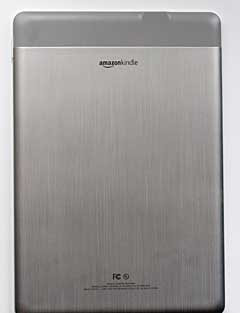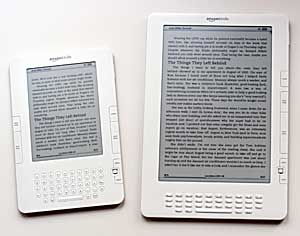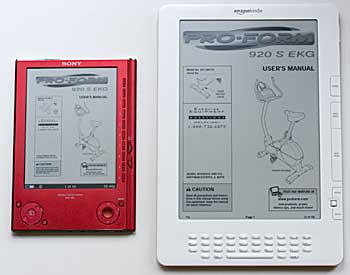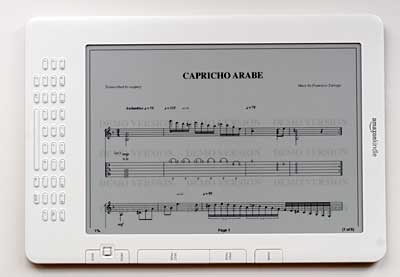|
|||||||||
Advertisement |
Home > eBook Reader Reviews > Kindle DX
Amazon Kindle DXEditor's rating (1-5): What's hot: Large display and native PDF support. What's not: Doesn't support as many formats natively as Sony Readers.
Editor's note, July 2010: Read our review of the Kindle DX Graphite with an improved display and lower price. It replaces the DX reviewed here. Reviewed June 15, 2009 by Lisa Gade, Editor in Chief Three and half months after Amazon released the Kindle 2 ebook reader, they’ve followed up with the super-sized Kindle DX. The DX looks, feels and acts much like its smaller brother—in fact the physical resemblance is uncanny. It’s nearly as thin (which is to say extremely thin), has that first gen iPhone-style brushed aluminum back with the plastic top section that covers the Whispernet antenna, has a QWERTY thumb keyboard for note-taking and searches, has a built-in dictionary and it has a grayscale e-ink display. Like the Kindle and Kindle 2, the DX works with ebooks sold by Amazon (over 300,000 as of this writing) and .mobi ebooks that aren’t copy protected. The Kindle DX sells for $489 while the Kindle 2 sells for $359.
The Amazon Kindle 2 and Kindle DX. What’s new? The Kindle DX adds native PDF support and a screen large enough to view most PDFs. The 9.7” diagonal display is 2.5x larger than the Kindle, Kindle 2 and Sony Reader PRS-505’s 6” display. The 6” readers have 800 x 600 pixel resolution 167ppi displays while the Kindle DX is 1200 x 824 at 150ppi. Like the Kindle 2, the DX has 16 shades of gray but images look better thanks to the larger display. The Kindle can rotate to landscape mode (in fact it can rotate in all 4 directions), which is useful for PDFs. The Kindle 2 can’t do this, while the Sony Reader 505 and PRS-700 support landscape mode. The Sony models require a button press to rotate, while the Kindle DX has an accelerometer so you need only turn the ebook reader to rotate the display. The accelerometer is sensitive but not overly so, and you can disable this feature if it bothers rather than helps and use a menu to switch orientation instead. Lastly, the Kindle DX has an improved web browser, though it’s not so fast and full-featured that you’ll be hankering to give up your cell phone’s data plan. Like the Kindle and Kindle 2, the Kindle DX has a QWERTY keyboard, and like those two, it can’t complete with the better QWERTY-phone keyboards on the market. While the Kindle 2’s are round, the Kindle DX keys are rectangular and smaller. The keyboard area itself is smaller, so that the device could be as small as possible. The numbers share keys with the top row of letters, so you must hit the alt key to enter numbers (a minor annoyance when using the go to page/location feature). The page turn buttons are only on the right side (the Kindle 2 has them on both sides). This may annoy those who regularly use the left side buttons on the Kindle 2, but as a leftie, I always use the buttons on the right. You can rotate the display upside down to move the buttons to the left side (the joystick reorients itself when you rotate the Kindle DX-- nice). Of course, the keyboard is difficult to use when the DX is upside down!
The display, as with all e-ink screens, is incredibly sharp and easy on the eyes with none of that laptop glare or eye-tiring 60Hz screen refresh. It’s a bit more contrasty and sharp than the Kindle 2, though it still doesn’t have quite the contrast of the Sony Reader 505 (the Sony’s background is whiter). Still, the Kindle DX has an excellent display for reading text and one can read for hours on end without suffering eyestrain. As with the Kindle 2, there are 6 text sizes to choose from (press the Aa button to select the size), and one standard system font for body text (the same font as the Kindle and Kindle 2). New for the Kindle DX is the Words per Line option: fewest, fewer and default. The font sizes are the same as the smaller Kindle, but obviously it displays more words per page given the larger screen, making the large print option more tolerable.
|
|
How about PDF documents? Amazon targets the Kindle DX at students and professionals who heavily use PDFs. The good news is that the display size is well suited to the common 8.5 x 11 inch formatted PDF standard, and we assume Amazon didn’t attempt native PDF support on the smaller Kindle because they’re often hard to read on a 6” display. The Sony Reader PRS-505 and PRS-700 also support PDF documents despite their smaller displays, and text can be difficult to read, as are diagrams with embedded text. But the Sony Readers have a 3 level zoom feature that helps with this, while the Kindle DX inexplicably lacks a zoom feature. If text is too small to read on the DX, you can rotate to landscape mode which enlarges text, and generally makes it readable (assuming you have reasonably good eyes). But if you find it too text is too small, you’re out of luck. Images and documents look great on the DX—better than on the Sony Readers. Also odd is the Kindle DX's lack of dictionary support (the Kindle has a built-in dictionary that works everywhere else) and there's no support for table of contents in PDFs. The Kindle DX sometimes misreads PDF metadata, including the author's name. It feels like Amazon rushed native PDF support out the door, and we hope they add at least TOC support in a future firmware update. The go to page function does work, so at least you need not hit the next page button 50 times to get to page 50. Despite these complaints, the DX overall does a very good job of rendering PDFs in a readable and pleasing fashion, including images which look sharp and detailed on the large display. It's amazing what only 16 shades of gray can do on an e-ink display in terms of image detail and natural, photographic style rendering.
The Sony Reader PRS-505 and the Kindle DX displaying the same PDF (exercycle manual). |
The Kindle DX displaying sheet music (PDF). It's a bit too small to read in portrait mode but requires too frequent scrolling in landscape mode were you to use it as a printed sheet music alternative. |
Battery life is about the same as the Kindle 2 and the Sony 505: 2 weeks with wireless off and 4 to 5 days with wireless on. The Sony Readers lack wireless, so there’s no comparison for that number. Wireless, which Amazon calls Whispernet, is actually a Sprint EVDO connection. There’s no monthly wireless fee though (excellent). You can use it to peruse, buy and download books from Amazon and surf the web using the Kindle’s basic web browser. You can also use it for delivery of your personal documents that are converted by Amazon. Each Kindle has its own email address, and you can submit HTML, DOC, JPEG, GIF, PNG and BMP files for conversion using your Amazon account and a computer. There's no charge for conversion and delivery if the converted document is emailed to your computer but Amazon does charge 15 cents/meg (rounded up to the nearest meg) if you have the document sent directly to the Kindle. There's currently no charge for browsing the web, nor does Amazon charge a delivery fee if you buy and download books from their web site using the Kindle. The Kindle DX can natively read Amazon AZW format, unprotected MOBI and PRC, PDF, Audible and MP3 music files, no conversion or emailing needed.
The web browser is improved over the Kindle 2. Part of this has to do with the larger screen being more conducive to web browsing and the other part is improved rendering. The Kindle DX has a desktop mode that won't make you think you're using IE on the desktop, but it does a reasonably good job even with heavy non-mobile web sites like the full New York Times home page. The DX gets better reception than the Kindle 2, which modestly improves download speeds but seems to do little for page load times which aren't nearly as a fast as 3G/EVDO web page load times on a smartphone.
 |
The page turn, menu and home buttons are on the right side. |
We had and still have great hope for improved periodical layout on the DX. A 6" screen is too small to replicate a newspaper or magazine's print layout but the 9.7" high resolution DX display would be perfect. Unfortunately, Amazon and their magazine and newspaper partners haven't changed layouts for the Kindle DX, and they look just as non-printish as they do on the Kindle 2. We have our fingers crossed that a DX-specific change is in the works, but that might be wishful thinking. It certainly would be a wonderful selling point for the Kindle DX if our wish came true!
The Kindle DX has 3.3 gigs of available storage and acts like a USB flash drive when connected to your Windows or Mac computer via the included USB cable. You can drag compatible documents to its documents directory and put music in the music folder. The Kindle DX uses the same tiny charger and USB cable as the Kindle 2. It has the same screensaver and set of rotating images as the Kindle 2, and it automatically switches to the screensaver after 10 minutes. Since e-ink only consumes power during page turns, the screensaver serves little purpose (OK, it looks neat) and I find it annoying: 10 minutes is too short, especially when it's not saving the screen or power. To power down the Kindle, slide and hold the power button until it turns off (this isn't a full shutdown and reboot, to do that you'll need to go into the settings menu).

Skinny readers: The Kindle 2 on top of the Kindle DX.
|
Conclusion Size matters, and the Kindle DX, despite lacking all the bells and whistles of full PDF support and a print-style layout for periodicals, makes for a better reading experience than the Kindle 2 and 6" Sony Readers. Granted, it's less portable-- if you're buying an ebook reader for plane trips or lunchtime reading where you can whip it out of your purse, then the 6" model makes more sense. But if you're using it at home, work or carrying it in a briefcase or notebook bag, the Kindle DX does everything the Kindle 2 does (including MP3 playback, Audible playback and text-to-speech) but better. Fewer page turns, better looking graphics and native PDF support on a display that's large enough to readably render 8.5 x 11" formatted PDFs is awesome. Though the Kindle DX is nearly twice as heavy as the Kindle 2, it's about the same weight as the Kindle 2 wearing Amazon's optional leather cover and lighter than a hardback book. If only Amazon would embrace ePub format (used by digital lending libraries), then we'd be even happier. Pro: Large display means many fewer page turns and it's big enough to display PDFs legibly. Text is sharp and clear with a bit more contrast than the Kindle 2. With 6 font sizes, anyone can read easily. Though not cheap, the Kindle DX is by far the least expensive large format ebook reader. Very thin and attractive. Con: Not as portable as the 6" readers on the market. PDF support isn't complete: no TOC, embedded links sometimes work and sometimes don't and there's no PDF zoom (hey, Sony can do this on a 200MHz PRS-505!). Native file format support is limited compared to Sony's ebook Readers and other less well known competitors. Price: $489 Web Site: www.amazon.com
Specs:
|






